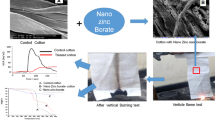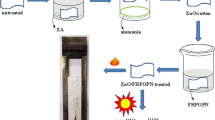Abstract
For the first time, facile synthesized ZnCO3 nanoneedles have been integrated into cotton fabric at around neutral pH as well as alkaline treatment condition (using NaOH) by following padding method to obtain fire retardant efficacy of the fabric. Fire retardant properties of the treated fabrics were studied by measuring limiting oxygen index (LOI) and vertical burning test. It was found that the fabric treated with nano ZnCO3 in alkaline condition showed LOI value of 30 and a specific char length of 40 mm with more than 40% char mass retention at 600 °C. Degradation behavior of the control and the treated fabrics has also been revealed in detail by using Thermo-gravimetric and Differential Scanning Calorimetry analyzer. Char morphology and the interaction of the nanoneedles with the treated fabric also have been demonstrated by using SEM and FTIR analysis, respectively.
Graphical abstract











Similar content being viewed by others
References
Alongi J, Carletto RA, Bosco F, Carosio F, Blasio AD, Cuttica F (2013a) Intrinsic intumescent like properties of the DNA treated cotton fabrics. Carbohydr Polym 96:296–305
Alongi J, Carletto RA, Blasio AD, Carosio F, Bosco F, Malucelli G (2013b) DNA: a novel green natural flame retardant and suppressant for cotton. J Mater Chem A 1:4779–4785
Alongi J, Carletto RA, Bosco F, Carosio F, Blasio AD, Cuttica F, Antonucci V, Giordano M, Malucelli G (2013c) Caseins and hydrophobins as novel green flame retardant for cotton fabrics. Polym Degrad Stabil 99:111–117
Alongi J, Blasio AD, Cutica F, Carosio F, Malucelli G (2014) Bulk or surface treatments of ethylene vinyl acetate copolymers with DNA: investigation on the flame retardant properties. Eur Polym J 51:112–119
Arputharaj A, Vigneshwaran N, Shukla SR (2017a) A simple and efficient protocol to develop durable multifunctional properties to the cellulosic materials using insitu generated nano ZnO. Cellulose 24(8):3399–3410
Arputharaj A, Prasad V, Saxena S, Vigneshwaran N, Shukla SR (2017b) Ionic liquid mediated application of nano zinc oxide on cotton fabric for multifunctional properties. J Text Inst 108:1189–1197
Basak S, Ali SW (2016) Sustainable fire retardancy of textiles using bio-macromolecules. Polym Degrad Stabil 133:47–64
Basak S, Ali SW (2017) Leveraging flame retardant efficacy of pomegranate rind extract, a novel biomolecule on ligno-cellulosic materials. Polym Degrad Stabil 144:83–92
Basak S, Ali SW (2018) Fire resistant behavior of the cellulosic textile functionalized with wastage plant biomolecules: a comparative scientific report. Int J Biol Macromol 114:169–180
Basak S, Saxena S, Chattopadhyay SK, Narkar R, Mahangade R (2015) Banana pseudostem sap: a waste plant resource for making thermally stable cellulosic substrate. J Indus Text 46:1003–1023
Basak S, Samanta KK, Chattopadhyay SK, Pandit P, Maiti S (2016) Green fire retardant finishing and combined dyeing of proteinous wool fabric. Colour Technol 132:135–143
Bitnec M, Marinsek M, Orel ZC (2008) Preparation and characterisation of zinc hydroxide carbonate and porous zinc oxide particles. J Eur Chem Soc 28:2915–2921
Coquelle M, Duquensene S, Casetta M, Sun J, Gu X, Zhang S, Bourbigot S (2015) Flame retardancy of PA6 using a guanidine sulfamate/melamine phosphate mixture. Polym 7:316–332
Gashti MP, Alimohammadi F, Song G, Kiumarsi A (2012) Characterization of nanocomposite coatings on textiles: a brief review on microscopic technology. Curr Microsc Contrib Adv Sci Technol 22:1424–1437
Gupta D, Basak S (2010) Surface functionalization of wool using 172 nm UV Excimer lamp. J Appl Polym Sci 117:3448–3453
Hingorani S, Pillai V, Kumar P, Multani MS, Shah DO (1993) Microemulsion mediated synthesis of zinc oxide nanoparticles for varistor studies. Mater Res Bull 28:1303–1310
Horrocks AR (2011) Flame retardant challenges for textiles and fibres: new chemistry versus innovatory solutions. Polym Degrad Stabil 96:377–392
Jordanov I, Mangovoska V, Tavcer PR (2010) Accessability of the mercerized, bioscoured and dried cotton yarn. Tekstil 59:439–447
Mostashari SM, Zanjanchi MA, Baghi O (2005) Burning of a cotton fabric impregnated by synthetic zinc carbonate hydroxide as a flame retardant. Combust Explos Shock Waves 41(4):426–429
Pan YT, Wang DY (2015) One-step hydrothermal synthesis of nano zinc carbonate and its use as a promising substitute for antimony trioxide in flame retardant flexible poly (vinyl chloride). RSC Adv 5(35):27837–27843
Pourmortazavi SM, Marashianpour Z, Karimi MS, Zadeh MM (2015) Electrochemical synthesis and characterization of zinc carbonate and zinc oxide nanoparticles. J Mol Struct 1099:232–238
Samanta AK, Bhattacharya R, Jose S, Basu G, Chaudhury R (2017) Fire retardant finishing of jute fabric using nano zinc oxide. Cellulose 24:1143–1157
Seshama M, Khatri H, Suther M, Basak S, Ali SW (2017) Bulk Vs nano ZnO: influence of fire retardant behaviour on sisal fibre yarn. Carbohydr Polym 175:257–261
Shamsipur M, Pourmortazavi SM, Hajimirsadeghi SS, Zahedi MM, Nasrabadi MR (2013) Facile synthesis of zinc carbonate and zinc oxide nanoparticles via direct carbonation and thermal decomposition. Ceram Inter 39:819–827
Shukla A, Basak S, Ali SW, Chattopadhyay R (2016) Development of fire retardant sisal yarn. Cellulose 24:423–434
Teli MD, Pandit P (2017) Novel method of eco-friendly single bath dyeing and functional finishing of wool protein with coconut shell extract biomolecule. ACS Sustain Chem Eng 5:8323–8333
Teli MD, Pandit P, Basak S (2018) Coconut shell extract imparting multifunction properties to ligno-cellulosic material. J Indus Text 47:1261–1290
Wahab R, Kim YS, Shin HS (2009) Synthesis, characterization and effect of pH variation on zinc oxide nanoparticles. Mater Trans 50:2092–2097
Wang W, Wang L, Liu L (2012) Morphology-controlled synthesis and growth mechanism of ZnO nanostructures via the NaCl nonaqueous ionic liquid route. Cryst Eng Commun 14(15):4997–5004
Zhang S, Fortier H, Dahn JR (2004) Characterization of zinc carbonate hydroxides synthesized by precipitation from zinc acetate and potassium carbonate solutions. Mat Res Bull 39:1939–1948
Author information
Authors and Affiliations
Corresponding authors
Rights and permissions
About this article
Cite this article
Sharma, V., Basak, S., Rishabh, K. et al. Synthesis of zinc carbonate nanoneedles, a potential flame retardant for cotton textiles. Cellulose 25, 6191–6205 (2018). https://doi.org/10.1007/s10570-018-1962-5
Received:
Accepted:
Published:
Issue Date:
DOI: https://doi.org/10.1007/s10570-018-1962-5




